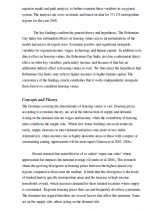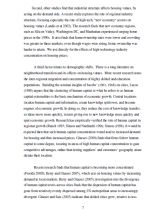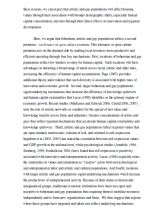Hledej
Zobraz:
Univerzity
Kategorie
Rozšířené vyhledávání
12 662
projektů
There Goes the Neighbordhood
| Přípona |
Typ projekt |
Stažené 0 x |
| Velikost 0,5 MB |
Jazyk anglický |
ID projektu 2934 |
| Poslední úprava 27.03.2014 |
Zobrazeno 971 x |
Autor: eliseus |
 Sdílej na Facebooku
Sdílej na Facebooku |
||
| Detaily projektu | ||
- Cena:
2 Kreditů - kvalita:
85,1% -
Stáhni
- Přidej na srovnání
- Univerzita:Univerzita Tomáše Bati ve Zlíně
- Fakulta:Fakulta managementu a ekonomiky
- Kategorie:Ekonomika » Management
- Předmět:Management
- Studijní obor:-
- Ročník:-
- Formát:PDF dokument (.pdf)
- Rozsah A4:34 stran
It is now a conventional wisdom that artistic, bohemian, and gay populations increase
housing values in the neighborhoods and communities they inhabit. But these groups
are small, and the evidence of their effect on housing prices is anecdotal. We argue
that artists, bohemians and gays through two kinds of mechanisms: aesthetic- amenity
premium and a tolerance or open culture premium. To examine this, we introduce a
combined measure of bohemian and gay populations - the Bohemian-Gay Index. We
conduct statistical analysis to test the efficacy and performance of this measure
against other variables that are expected to effect housing values: income, wages,
technology, and human capital. The findings indicate that the Bohemian-Gay Index
has substantial effects on housing values across all permutations of the model and
across all region sizes. It remains positive and significant alongside variables for
regional income, wages, technology and human capital. The Bohemian-Gay Index
also has a substantial direct effect on other key variables, particularly income, and
because of that has an additional indirect effect on housing values.
housing values in the neighborhoods and communities they inhabit. But these groups
are small, and the evidence of their effect on housing prices is anecdotal. We argue
that artists, bohemians and gays through two kinds of mechanisms: aesthetic- amenity
premium and a tolerance or open culture premium. To examine this, we introduce a
combined measure of bohemian and gay populations - the Bohemian-Gay Index. We
conduct statistical analysis to test the efficacy and performance of this measure
against other variables that are expected to effect housing values: income, wages,
technology, and human capital. The findings indicate that the Bohemian-Gay Index
has substantial effects on housing values across all permutations of the model and
across all region sizes. It remains positive and significant alongside variables for
regional income, wages, technology and human capital. The Bohemian-Gay Index
also has a substantial direct effect on other key variables, particularly income, and
because of that has an additional indirect effect on housing values.
Klíčová slova:
Housing
human capital
creative class
income
gay
artistic
Obsah:
- Abstract
Introduction
Model
Variables and Data
Methods
OLS Results
Findings from Structural Equation Models and Path Analysis
Region Size Effects
Conclusions
References
Zdroje:
- AMABILE, T. (1996) Creativity in Context, Boulder, CO: Westview Press
- BERRY, C. R., GLAESER, E. L. (2005) The Divergence of Human Capital Levels Across Cities, NBER Working Paper No. 11617, September 2005.
- CASTELLS, M.. (1983) Cultural identity, sexual liberation and urban structure: the gay community in San Francisco, in The City and the Grassroots: A Cross-Cultural Theory of Urban Social Movements, London: Edward Arnold,138-170
- CLARK, T. N., LLOYD, R., WONG, K. K., JAIN, P. (2002) Amenities Drive Urban Growth, Journal of Urban Affairs, 24:5: 493-515.
- CLARK, T. N. (2003) Urban Amenities: Lakes, Opera and Juice Bars Do They Drive Development? In: The City as an Entertainment Machine. Research in Urban Policy, Volume 9: 103-140, Oxford: Elsevier Ltd.
- CURRID, E. (2006) New York as a Global Creative Hub: A Competitive Analysis of Four Theories on World Cities, Economic Development Quarterly, 20(4): 330-350
- CURRID, E. (2007) The Warhol Economy, Princeton University Press, forthcoming
- FLORIDA, R., GATES, G. (2001) Technology and Tolerance - The Importance of Diversity to High-Technology Growth, Urban Institute, June 01
- FLORIDA, R. (2002a) The Rise of the Creative Class, New York: Basic Books.
- FLORIDA, R. (2002b) The Economic Geography of Talent, Annals of the Association of American Geographers, 92(4): 743-755.
- FLORIDA, R. (2002c) Bohemia and economic geography, Journal of Economic Geography, 2: 55-71.


